System Review – PC-Club Silencer
by Jarred Walton on March 28, 2005 12:05 AM EST- Posted in
- Systems
General Performance and Encoding
We'll start with the WinStones 2004 results. The real world application of these scores is dubious, as most business/office applications tend to spend most of their time waiting on the user. However, we include them as a general indication of system performance. For more detailed benchmarks, we recommend that you look at our full coverage of Pentium M on the Desktop.
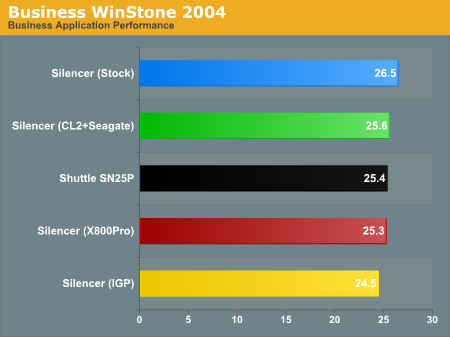
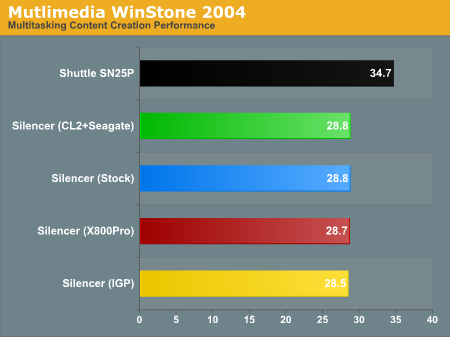
The Content Creation side of things is even closer in terms of the Silencer performance. Not even the IGP configuration really differs that much in performance. Here, however, we see the handicap of the Pentium M architecture. The Athlon 64 is noticeably faster, topping the highest configuration of the Silencer by just over 20%.
For our encoding test, we use AutoGK to encode a chapter from the “Sum of All Fears” DVD to 75% quality without audio, using both the DivX and Xvid codecs. These are one-pass encoding runs, which don’t get the best conversion quality, but they do provide a look at the video encoding performance of a system. As a more realistic re-encoding benchmark, we'll also include the time required to encode the sample video that we used in our Socket 478 and 745 SFF roundup to a target size of 5 MB, this time including stereo audio and with a fixed video width of 640 pixels. There are 900 frames in the video clip, so you could try to calculate an overall FPS rate for the conversion. We prefer to look at the total time rather than just a single pass, however, as AutoGK 1.60 ends up doing three complete passes plus some miscellaneous work to arrive at the final result.
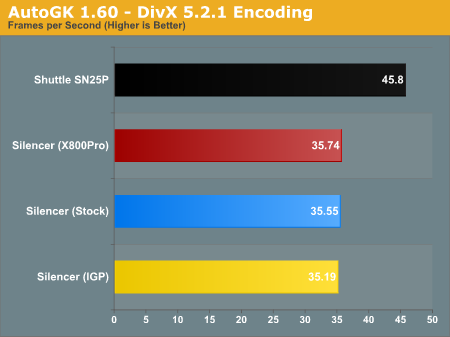
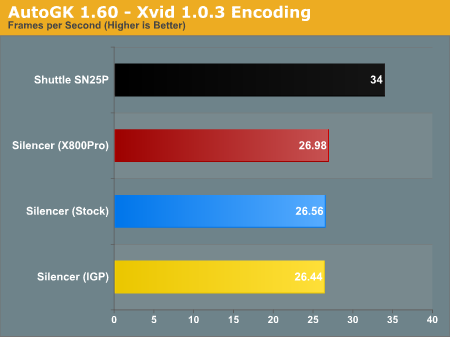
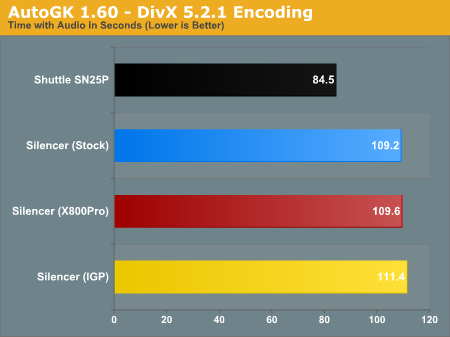











22 Comments
View All Comments
yacoub - Sunday, May 29, 2005 - link
"If you lack such amenities and live in an area where indoor temperatures can break 90 C,"90 degrees Celcius?! LOL!! :D
JarredWalton - Friday, August 26, 2005 - link
Oops... fixed.finbarqs - Friday, April 1, 2005 - link
I stand neutral on this situation. Perosonally, I'm not into small computers, but i think that the Pentium M is an incredible platform, offering insane performance for such low clock speeds. (Instructions per clock?) but anyway, expensive to say the least... But it WAS a good idea to offer the Pentium M to the mass market....JarredWalton - Wednesday, March 30, 2005 - link
PC-Club asked us to review their Silencer. Find me another Pre-built Pentium M system from anyone on the market - I'm not aware of any. If HP, Dell, Micron... whoever asks us to review a system, we'll do our best to accommodate them. Besides, PC-Club is not exactly small - there are over 50 retail outlets scattered across the US, although the majority are in CA.michael2k - Wednesday, March 30, 2005 - link
#17: Statistically speaking, most people are average, so "the 75% of the hard core" would probably be more like the "10% of the readership".So this box is targeted towards the "30% average" who can't build a better box. My numbers are made up of course, but it's true that statistically the average probably can't build a decent PC.
Besides which, if I wanted a PC for 25% of the cost, 60% of the performance, and even quieter, I would buy a Mac mini, and Anand has very thoughtfully reviewed one for us.
deathwalker - Wednesday, March 30, 2005 - link
#16...its a good thing our federal government doesn't ever violate us!!....PC club? Lord where will we go next when we get desperate. I imagine the 75% of the hard core Anantech followers could do as good or better. How is it these jokers get space on this valuable tech. info website? I suppose next time i throw a box together I will write my name on it in crayon and send it in for a review.ElFenix - Tuesday, March 29, 2005 - link
technically, you're supposed to remit sales tax to your local taxing authority on mail order purchases. when i worked at dell they pounded into us that you cannot tell people they save money because they don't have to pay sales tax. doing so is a violation of federal law.Zepper - Monday, March 28, 2005 - link
Yes, PC club should have wired the case's LCD into the +5VSB circuit and/or provided battery backup for it. Any tech that can find his butt with both hands should have been able to figure that one out. But I still like the Athenatech A100 series - hard to beat for the price.. But when I'm building something that will total that much perhaps a Chenbro or Enermax Venus caae would have been a better choice.
.bh.
JarredWalton - Monday, March 28, 2005 - link
Just in case this isn't clear (#12), I *DO* like the system. The problem is that when a system is close to getting everything right, it just makes the areas where it falls short more noticeable. If I were actually buying the system, I'd go with the CoolerMaster case and two Seagate/Samsung HDDs. Also, $100 for assembly is generally less than I charge people. For a full PC setup with OS and software, I typically charge $150 unless it's a close friend/family member.#9 - Yes, you can build something reasonably silent on your own. I sort of take that as a given. Although I think you'll often pay more in the end, people that like to build their own PCs aren't really the target market for this system.
#10 - The point on taxes was that depending on location, it can add a lot. If you buy online from a site that doesn't have a retail presence in your state, you don't get hit with taxes. (I.e. Newegg is in CA and NJ, so if you live elsewhere you don't get taxes added in.) Now granted, you're *supposed* to pay taxes on these items anyway, but I don't know anyone that does. :p
#11 - I absolutely stick with my assessment of the Fuji S5000. Of course, the graininess is really a big problem when you're doing closeups. For pictures of people and such, you won't notice it much. Tweaking the colors and such also tends to make the graininess show up more, but it's necessary at times. It's not a *terrible* camera, but there are better alternatives in the price range.
#13 - The PSU is standard. My comment on the "usually a 200W" is related to the case purchased separately, i.e. at Newegg. The comments on the speakers and sound I agree with. I don't think an Audigy 2 ZS is necessary for most people, and it is an option at PC-Club (for $100 - retail version).
*Whew!* I think that covers everything. Again, I think PC-Club did a good job with this system, but there are still flaws and I feel it's my job as a reviewer to point them out. I hope that my article convinces them to offer an Athlon 64 flavor in the near future, as I think that would be a better alternative for gaming.
blckgrffn - Monday, March 28, 2005 - link
I would be pretty pissed if I got this computer, too. The components seem to be mismatched... having owned a Falcon-Northwest, I can attest to the fact that people who don't buy a dell or an emachine are going to be very picky about the system that they paid a good premium for. Any system from any OEM that wants to be considered elite needs to be well thought out and well implemented. I remember looking inside my Falcon and just saying wow about the cable management, the fans were quiet but pushed a good amount of air, and all of the components were at home with each other - unlike having a Raptor and a crazy loud fan in a SFF PC. That is just dumb and makes you wonder what they were thinking. Also, there was an allusion to a Power Supply upgrade just for Anandtech - a video card like that pretty much crys out for a 250watt+ QUALITY powersupply, not just a generic 200 watt one.I admit the price looks good for this system considering the components, but do not forget that it is supposed to be a gaming box - why wasn't there at least a Audigy 2zs thrown in for good measure? Ridiculous, as well as the speaker choice for a $2,000 system. I think that the FragBox from Falcon-NW is a very good SFF PC alternative, or if you don't care about size grab a good deal on an XPS.
This article was a nice bit of fresh air, it seems that too many reviews (not here, really, but in general) seem to overlook flaws rather than point them out. If I wanted to hear about how great a product was, I would read their marketing BS.
Thanks you Mr. Walton for an honest review.